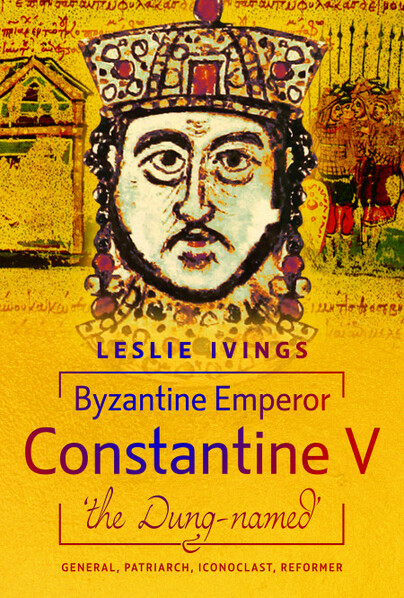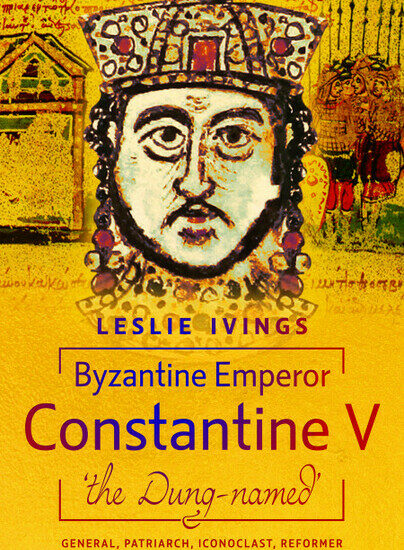Imperial Matrons and the Shadow of Iconoclasm: Women in the Age of Constantine V
By Leslie Ivings author of Constantine V ‘The Dung Named’
The reign of Constantine V, emperor of Byzantium from 741 to 775, is often remembered in stark and polemical terms. He has come down to us as a figure of great contrasts: a capable general and administrator in the eyes of some, a tyrant and heretic in the eyes of others. His most defining legacy was his uncompromising commitment to iconoclasm, the rejection and destruction of religious images. Yet amid the controversy and conflict of his long rule, an often-overlooked aspect of this era lies in the lives and influence of the women who moved within, around, and eventually beyond his court.
In the Byzantine world, women were not supposed to rule openly. They were wives, mothers, patrons, sometimes regents but rarely were they seen as sovereigns in their own right. And yet, from the mid-eighth century onward, we begin to see a rising tide of female agency, some of it quiet and spiritual, some of it bold and explicitly political. The reign of Constantine V, for all its harshness, helped set the stage for a period in which women, imperial women in particular, would come to shape the empire’s future.
Constantine V married three times. His third and most prominent wife, Eudokia, gave birth to Leo IV, his eventual successor. Little is known of her beyond her role as imperial consort and mother, but this silence in the sources does not imply insignificance. Byzantine empresses, though often confined to the ceremonial and domestic spheres, held real influence within the palace. They were guardians of dynastic continuity, patrons of religious institutions, and managers of internal court alliances. They were also responsible for raising imperial children in line with the reigning ideology which in this case was iconoclasm. It was in this environment that Leo IV was raised and prepared to inherit both his father’s throne and his theological convictions.
Outside the court, the iconoclastic policies of Constantine V triggered waves of resistance, especially among the monastic communities. Women were part of this spiritual struggle. Abbesses and female ascetics, though rarely named in contemporary sources, became central figures in opposing imperial policy. Some preserved icons in secret, others encouraged veneration in defiance of the law, and many more sustained religious communities where traditional piety, centred on images and relics, was quietly upheld. Later hagiographers, writing under the restored iconophile regimes, would canonise these women as heroines of the faith, spiritual warriors who stood firm against what they saw as imperial heresy.
Among them, the figure of Anthousa of Mantineon stands out, though her story must be treated with caution. According to later sources, she was an abbess known for her miracles and prophetic insight. In one popular account, Constantine V’s wife suffered complications during childbirth and the emperor, despite his persecution of iconophiles, sought Anthousa’s prayers. She allegedly foretold the safe delivery of the child and predicted the future greatness of the newborn. While this tale is likely apocryphal, created after the fact to sanctify opposition to iconoclasm it is revealing. It shows how women’s spiritual authority was understood, even by their enemies, to be potent and persuasive.
Though most of the prominent women under Constantine V were operating in the shadows of official history, one figure who would emerge shortly after his death changed the rules entirely. Irene of Athens, born into a noble but not particularly distinguished family, was selected as a bride for Constantine V’s son, Leo IV. She entered the court in 769 as a twenty-something Greek-speaking outsider from the provinces. What followed was one of the most remarkable political careers in the entire Byzantine story.
After Leo IV’s death in 780, Irene assumed the regency for her nine-year-old son, Constantine VI. She did not rule as a placeholder or passive caretaker. Instead, she began to consolidate power in her own name. She restored the veneration of icons, hosted the Seventh Ecumenical Council at Nicaea in 787 to repudiate her father-in-law’s iconoclast theology, and surrounded herself with advisors drawn from the monastic and iconophile camps. Her motivations were undoubtedly political as well as religious. By allying herself with the iconophile cause, she secured support from the Church, the monasteries, and key factions within the bureaucracy who had tired of religious persecution.
Irene’s power only grew. By 792 she had forced her son to accept her as co-ruler, and by 797 she had him blinded and deposed which was a shocking act, but one that eliminated her last rival. For the next five years, she ruled as emperor, not empress, taking the title Basileus rather than Basilissa. Her coins bore her image alone, and she acted with the authority of a male sovereign in a society where women were not expected to hold power alone.
This was no mere anomaly. Irene’s ascent marked a turning point. Although her reign ended in 802 when she was overthrown in a palace coup, she left a powerful precedent. The position of imperial women had changed. No longer confined to regency or ceremonial piety, women could now be seen, however uneasily as sovereign rulers in their own right.
Irene’s legacy cannot be separated from that of Constantine V. Her rule was, in many ways, a direct repudiation of his. Where he had torn down icons, she raised them up. Where he had disciplined the Church, she sought its blessing. Where he had promoted a strictly militarised and doctrinaire imperial image, she revived the old traditions of divine favour and saintly intercession. Even her very gender became a kind of theological statement: the empire, she seemed to suggest, had lost its way under male tyranny and found redemption through a pious woman.
What is striking, however, is how Constantine V’s legacy continued to shape the world Irene inhabited. The empire she ruled had been transformed by decades of religious purging and military centralisation. The institutions she relied on imperial coinage, palace ritual, ecclesiastical councils had all been hardened under her father-in-law’s rule. In a sense, Irene did not simply overturn his legacy. She inherited it, wrestled with it, and redefined it.
Other women would follow in Irene’s footsteps, although none would rule with quite her authority for some time. Still, the door she opened could not be closed. In the ninth century, Empress Theodora, another remarkable figure, would complete the restoration of icon veneration and reaffirm the role of women as defenders of the faith. Even in the twelfth century, Byzantine chroniclers looked back to Irene not as a curiosity but as a legitimate, if controversial, sovereign.
What began under Constantine V as an era of imperial consolidation and doctrinal rigidity ended, paradoxically, in a moment of unexpected female empowerment. His reign provoked a spiritual backlash that found its most powerful voice not in a bishop or a general, but in a woman from Athens who rose to rule the empire.
In the end, the story of women in the age of Constantine V is a story of silence and resistance, of official erasure and spiritual resilience. It is a reminder that history is not always made by those who shout loudest or build the tallest walls. Sometimes it is shaped in the quiet rooms of monasteries, the whispered prayers of abbesses, the education of children, and the firm decisions of empresses who refuse to be set aside.

Order your copy here.

